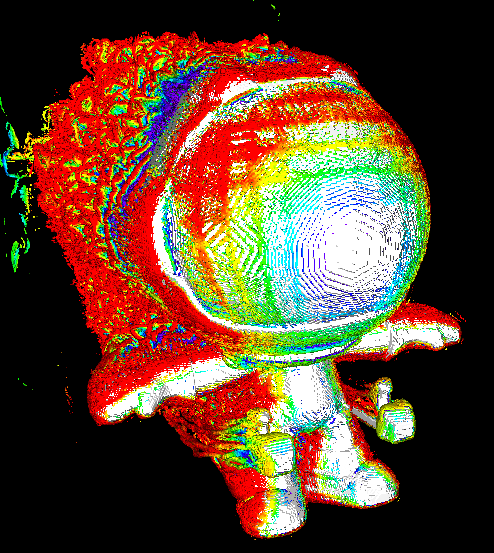When Newton worked out the laws of motion, he figured they had to be correct because they were so simple and elegant.
He had no idea that relativity was going to come in and fuck his shit up.
And then there was quantum.
Do you have any idea how fast you were going?
No officer, but I can tell you exactly where I am!
Which is also simple and elegant
And then string theory. Which . . .
The music of the universe is a symphony, damnit. That’s inherently complex!
It’s a genuine shame the vibrating strings of reality sound like tinnitus to me.
Eeeeeeeeeeeeeee
Which is also simple and elegant
“Noooooooooo!” -Albert Einstein
He did also notice that the planets didn’t move quite exactly as he predicted and said “well, God must keep them in place”
“Now excuse me I’m going to go behead some counterfeiters.”
TBF the laws of motion are still correct.
it’s not that they are “correct”, it’s that they are a close enough approximation to work well enough at the scale they’re used. it’s not like the universe runs on math.
I mean relativity is elegant enough in its own right; it’s just Newton’s laws plus the constancy of the speed of light and the equivalence principle. These two additions are enough to make everything an order of magnitude more fucked up, but that’s math’s fault, not relativity.
now do quantum
He definitely miscalculused the turnstables…
relativity only applies at large scales and quantum at small scales.
for everything else, esp earth bound, classic mechanics is works just fine.
The point is that he just assumed there was nothing more to know. And he was wrong (tho I’m not gonna knock the dude who invented calculus too hard).
The comic is trying to point out that bigotry is generally born out of a lack of curiosity.
And i’d fundamentally disagree. plenty of curious people use their curiosity to perpetuate and develop new forms of bigotry.
history of science is loaded with people using new concepts to perpetuate and reinforce racism, sexism, etc. and that is still very much done today.
it’s a naive to assume curiosity is a cure for ignorance. some of the most curious and smart people I know are also the most racist/sexist and pridefully ignorant. some of the dumbest/least curious people I know the least bigoted.
if anything, i’d say the biggest correlation is about whether or not the person believes in a sense of a social pecking order/competition. those who deeply believe in it are furiously trying to crab bucket their way up it by pushing others below them. those who don’t… just don’t care about people’s perceived status no matter it’s basis.
knowledge is a cure for nothing. it’s just knowledge. and knowledge changes over time.
Interesting take. Thanks for sharing.
“applies” isn’t the word I would use. It’s not like nature has a line that once you pass some threshold of mass, acceleration or distance it needs to flip the relativity switch.
Probably say “becomes noticable”.
Related:

A lot of problems in the world can be attributed to people who think “if I don’t understand something, it must be because the experts saying it are all wrong”.
Spot on
A genderino sounds more like something you’d find in particle physics than biology anyway
Considering the names of the types of quarks, I recommend renaming them genderinos.
finally, we found what genderfluid is made from
Physicists are freaky, like who was out there going and asking quarks what is their power dynamic in sex?
“I’m a charm in the streets, and a strange in the sheets.”
I’m down for a strap on, but what is a glue on??
This guy rotates
Right alongside gender fluid.
It also kinda sounds like a Pokémon!
though the meme is cool, gender isn’t particularly a biology (or ‘advance biology’) thing. biology deals with sexes, their expressions and functionalities. gender is more of a personal and social concept but often related to sex characteristics (cis).
and yes, advanced biology tells sex determination isn’t as easy as XX or XY or even looking at genitals like a creep.
and oh, for giggles consider fungi :)
Adding to this: XX and XY works for mammals, but not for other vertebrates (fish, birds, reptiles, amphibians). Birds and reptiles have Z and W chromosomes, and unlike in mammals where females are homozygotes, males in these groups are homozygotes. Some reptiles have temperature dependent sex determination, where ambient temperature above some value will produce males or females (depends on species). Some reptiles are composed entirely of females.
Some fish will straight up change sexes depending on age and male-female ratio in a social group.
In other groups it’s not even different chromosomes but simply copy number of specific genes.
Plants can do all sorts of whacky things like produce seeds and pollen in the same individual.
Fungi are an entirely different cluster fuck because they have mating types which are not simple binaries.
Eukaryotic sex determination isn’t a binary and it isn’t even a nicely categorizable spectrum. It’s a grab-bag of whatever doesn’t perma-fuck your genome.
Source: me, I’m a biologist. Though admittedly I work on animals so my understanding of fungi and plant stuff is fuzzy at best.
And bee queen generate full-animal-sized flying sperm, aka drones.
I would say gender is probably centered about around psychology, ranges mostly from sociology to biology, with a just little bit going into chemistry
maybe like

What’s the y-axis?
it’s a normalized distribution. The y-axis is unitless.
More yes
practical importance to gender
As perceived by me
(only the most scientific of measurements)
Reason for another XKCD comic about bad graphs (or ten).
purity.
as in whether it applies to the real world is entirely a symbolic construct that has no use/reflection of the real world.
Slime mold(which is not a mold or fungi) looks around nervously in it’s 13 different sexes.
What kind of fungi should I consider for the maximum giggles?
I don’t entirely agree, because gender identity is known to be at least partially biological, e.g. there are correlations between transgender, skin elasticity, and hyper-flexibility.
just FYI, “transgenderism” is a word to avoid (at least if you don’t want to be perceived as transphobic)
and yes, gender identity seems to be biological, and genetic.
my bad, updated to “transgender,” I read online that’s the preferred noun form (though it looks more adjectival to me)
gender identity is clearly not primarily genetic, as twin studies suggest otherwise.
I think in clinical and scientific contexts the term “gender dysphoria” is used, but the trans community would probably prefer trans be used as an adjective and not a noun, someone is transgender, but not “a transgender”, if that makes sense.
also, the twin studies show gender identity is genetic and heritable:
https://en.m.wikipedia.org/wiki/Causes_of_gender_incongruence
The significant percentage of identical twin pairs in which both twins are trans and the virtual absence of dizygotic twins (raised in the same family at the same time) in which both were trans would provide evidence that transgender identity is significantly influenced by genetics if both sets were raised in different families.
In 2018 a review of family and twin studies found that there was “significant and consistent evidence” for gender identity being genetically heritable.
gender dysphoria is not what I’m talking about, since not all transgender people have dysphoria.
To be clear – “transgender” the noun is not referring to a person (“that person is a transgender”* – proscribed) but rather as a substitute for “transgenderism”* (proscribed). Personally, using “transgender” seems linguistically strange to me and it just reminds me of Trump saying “transgender for everybody” but if it’s what people prefer then who am I to judge.
Anyway – yes, I agree that it seems very probable that there are strong genetic components to transgender, but it’s also clearly not purely genetic, given there are identical twins where one is cis and the other not.
gender dysphoria is not what I’m talking about, since not all transgender people have dysphoria
right, I get that, but most research has not treated being trans outside the context of gender dysphoria, so when talking about studies or the clinical and scientific context usually non-binary and non-dysphoric trans folks are left out of the picture.
It is good to be expansive in our concept of being trans for social justice reasons, and to not gatekeep for harm reduction reasons, but since scientists and clinicians are gatekeepers, what we can say about their findings are limited to the criteria they use. It is usually more accurate to say “a study found X or Y about people with gender dysphoria”, even though it’s not uncommon for that to be presented as “a study found X or Y about trans people” in more mainstream contexts.
To be clear – “transgender” the noun is not referring to a person (“that person is a transgender”* – proscribed) but rather as a substitute for “transgenderism”* (proscribed).
I have never seen this usage, and like you I’m skeptical that is right. I could see “being transgender” as a substitute for “transgenderism”, but not just “transgender”.
but it’s also clearly not purely genetic, given there are identical twins where one is cis and the other not.
The presence of identical twins where one is cis and one is trans is not proof that gender identity is not genetic - there are many reasons people do not transition or acknowledge their gender identity, such as the strong social pressure to not be trans. There can also be epigenetic differences so while identical twins may share a genome, how it is expressed differs based on a variety of conditions that alter epigenetics, such as stress or illness.
We see the same with sexual orientation by the way.
Granted, it’s not proof, but I find it very hard to believe that all cases of identical twins with apparently differing gender identities is explained by one of the twins simply electing not to transition while the other does. This is particularly hard to believe given that the twins grow up in similar environments, so if one is in a transition-hostile environment the other likely is as well. I think we should believe people when they insist they are not transgender, especially if they are part of a study where their identical twin is comfortable being open about it. If this were a rare occurrence, I would be more inclined to agree with you, but it is not rare at all.
“transgender”
One instance where I have seen “transgender” used this way is from the same article where I learned about the link between transgender, skin elasticity, and hyperflexibility:
it’s at least possible that EDS and transgender are linked
It’s no typo; other articles by this same author use the same grammar. I have also for sure seen this used on other sites, including by trans authors, but in 5 minutes of searching I can’t find those instances. “Being transgender” does seem grammatically fitting to me, but it doesn’t always make sense to use “being transgender” as a substitute for “transgenderism”*/“transgender.” Anyway we more or less agree here and I have little interest in semantics.
Psychology is technically a branch of advanced biology
plenty of animals can gender swap, be hermaphrodites, or produce asexually.
But it easy, we just make it complicated with social bullshit and attention craving. The fact that no one is exactly set to be perfect copies, doesnt mean anything. The fact that outliers exist, doesnt mean anything. You ask the owner of a dog if its a boy or a girl, they will tell you. And you wanna know how they know? They looked between its legs. It really is, that easy.
The kind of logic being pushed today, is basically saying that you cant class human beings as a bipedal species because 200 per million people are born with no legs. Which is dumb as fuck.
I think things get taken too far in some contexts, but the underlying sensitivity is when you are talking to a person who considers themselves an outlier. Like telling someone with no legs that they don’t meet the definition of human and ADA is an abomination that should be repealed. Or telling someone diagnosed with conversion disorder that they can’t receive any physical accommodations, and can’t have any medical consults to check if their symptoms might have a different cause. I hope we can agree those would be insensitive positions to take.
Why would I say someone with no legs wasnt human? If anything, that would be your stance. No? Im not the one excluding outliers, you all are. And then your using 0.018% of the population to justify it.
I am confused. I thought the thread was about gender, and the reference to “social bullshit” and the statement “that outliers exist, doesnt mean anything” were statements in support of excluding transgender people from society. The 0.018% stat (rate of intersex if defined narrowly) is clearly a reference to sex, not gender. So now I am just lost.
Now you know how everyone else feels. It used to be focused on gender. But theres been a pivot to sex. Why? I dont know. It seems like people all of sudden want “trans” be a dirty word, and by people, I dont mean MAGA chuds who hate anything that its them.
‘I am biologically female.’ was said by Beth Upton, during a court case into whether or not she received abuse from a Nurse. Followed by: ‘the terms biological male and female had no defined and agreed meaning in science’ and ‘Biological sex is a nebulous term and it doesn’t really mean anything, because nobody can accurately or usefully define biological sex because pretty much every human I’m aware of is at least in part biological and many of them have a sex characteristic.’
Similar things are popping up all over social media. I dont care what anyone says they are. Trans, non binary, whatever. They can all live their lives as they see fit. Its this push to justify it with outliers thats annoying. And it just takes us right back to the arguments over attack helicopters, which I thought were long behind us.
i think that if more people were exposed to advanced math there would be a reactionary trend of people going around and asking mathematicians “what is a number?”
sort of like the reactionary trend of pulling your kids out of school because Common Core has changed how math is taught so critical thinking and conceptual understanding is incorporated, rather than teaching math by rote memorization?
I’m shocked that the US only adopted this in 2009. I’m pretty sure my mum, who went to primary school in the 70s, recognized number lines when I was taught to use them on 2005ish. I’m having a hard time imagining how else you’d explain it.
look, we work very hard on being reactionary here in the U.S., we’re a world leader in reactionary politics, and not teaching math well is crucial to keeping a vibrant
slaveworker population, otherwise they might start, you know, thinking for themselvesFirst you make them memorize single digit subtraction X - Y where X >= Y. Then you extend that to small double digit numbers.
Then you teach “borrowing”. 351-213. Subtract the 1s column. Can’t take 3 from 1, so borrow 10 from the 5 in the 10s column, making 11 in the 1s column and 4 in the 10s.
Definitely more clear, right?
So, I understand that the number line is a way to conceptualize relational distances between numbers, but in that example I’m struggling to see the relation between 57 where the line ends and 111, the answer. If you have insight, do you mind elaborating?
Edit: actually… Aren’t the numbers they wrote in on the line WRONG? Why did they go down by 20 to 107, then by 10 to 57 arbitrarily? If you do 10 instead, then increment by 1 to 111… You get the answer. Did the person solve it wrong and put the right answer to get people outraged?
I think they were trying to demonstrate the second type of dot should be increments of 10 - the missed step in the original answer - and both messed it up (started with an increment of 20 as you pointed out) and extended it way beyond what was required for the problem at hand.
Okay at least I know I’m not just going senile trying to interpret this haha.
I believe that’s what happens anytime they say that we probably shouldn’t focus on memorizing a multiplication table, or try to teach anything in a way that puts more focus on understanding how numbers work than on symbolic memorization.
And that’s like… Elementary school.The whole new math everyone was complaining about is trying to do this. Granted teachers are human and flawed so sometimes it has not been implemented well, but it is aimed in the right direction.
I am absolutely going to start responding to questions / statements about gender with this concept though.
“There are only two genders”
“Yeah, and there are only 3 states of matter! These woke scientists with their DEI alphabet soup of mattet B-E Condensates, and QSL, and DEGERATE MATTER! Its sick I tell you”
I was going to make a comment about surreal numbers not being numbers. But I did a bit of fact checking and it looks like all of the values I was objecting to are not considered surreal numbers, but rather pseudo numbers.
I find this outrageous. Why can’t ↑ be a number? What even is a number that would exclude it and leave in all of your so-called numbers?
Where in those axioms does it say that ↑ = 0 = 0 } is not a number? No where, that’s where!
The actual reason that ↑ is simply that it is too ill behaved. The stuff I thought were the “numbers” of combinatorical game are actually just called Conway games. Conway numbers are defined very almost identically to Conway games, but with an added constraint that makes them a much better behaved subset of Conway games.
I suppose you could call this an axiom of combinatorical game theory; but at that point you are essentially just calling every definition an axiom.
<s> Getting back to my original point; this distinction just goes to show how small minded mathematicians are! Under Conway’s supposed “reasonable” definition of a number, nimbers are merely games, not proper numbers. However, the nimbers are a perfectly good infinite field of characteristic 2. You can’t seriously expect me to believe that those are not numbers! </s>
There is a slight difference though in that complex numbers are a part of math but gender isn’t really a part of biology.
Also the mathematicians wouldn’t decline to give an answer.
Also the mathematicians wouldn’t decline to give an answer.
Are you sure? I only minored in math, but even I would struggle to provide an answer to this. It would have to be something incredibly vague, like “a number is a mathematical object that has certain consistent properties relevant to the field of study.” Because otherwise you get situations like “is infinity a number?” and you can’t answer categorically, because usually it’s not, but then you look at the transfinite numbers where you can indeed have omega-plus-one as a number. And someone asks if you can have an infinite number of digits to the left of the decimal place, and you say “well, not in the reals, but there are the P-adic numbers…” and folks ask if you can have an infinitely small number and you say “well, in the reals you can only have an arbitrarily small number, but in game theory there are the surreal numbers, where…”
So yeah, I’m not sure “what is a number” is even a math question. It’s more a philosophy question, or sometimes a cognitive science question (like Lakoff and Nuñez’s “Where Mathematics Comes From”).
Gender isn’t part of biology (as a social construct) but the complexity of sex absolutely is.
Can confirm. I was already struggling. But I just straight up refused to math with i
Advanced mathematicians see a numeric digit and ask “what’s that?”
Ehh not really its just to old if a concept for us to be appaled by that. Its not 15 century for imaginary numbers to cause riots.
have you taught?
anytime you give people a new metaphorical hammer, they want to go around banging everything they can with it. then they get bored and forget about it.
pop psych is a great example. people love to go around diagnosing everyone with whatever new schema of diagnosis is popular and trendy. trans is very trendy right now and it’s become on point for kids to identify as trans or some other non binary sexual identity. whether or not it sticks in the future, not sure. there is a counter-movement as well towards reinforce trad gender binaries in the dating sphere for sure. i’ve noticed as i age that a lot more people start caring a lot more about trad gender role stuff than they did in my 20s.
I’m a career physicist, and I honestly have no idea what a state of matter is anymore.
Can I offer you a nice smectic B3 liquid crystal in this trying time?
You may not.
An abstraction used for grouping kinds of things together for the purposes of making thinking about them a lot faster.
yeah i have a bachelor’s in chemistry and I remember a professor earnestly saying the phrase “metallic phase nitrogen” and I think I went home and stared at the ceiling for an hour
Loads of pressure? Even Quarks get metallic with enough pressure.
Yeah apparently there’s metallic nitrogen in the Earth’s core
I would wager you have more of an idea of what a state of matter is than biologists do of what a species is. Humans like to put things into neat boxes but nature is under no deal obligation to cooperate.
I’d actually argue the opposite. With states of matter, we’re attempting to delineate how reality groups together sets of related properties that vary between conditions in similar ways for different substances.
Looking for the edges that nature drew.With species though, we drew the lines. We drew them with a mind towards ensuring it’s objectively measurable but it’s still not a natural delineation. Taxonomists (biologists are actually a different field) mostly run into uncertainty with debating which categorization property takes precedence, and what observations of species have actually been made.
So while they debate which system to use, the particulars of the systems are pretty concrete.States of matter and species are both cases where we drew the lines based on what we thought was obvious. Then we ran into cases that were not so obvious anymore and challenged how we define these lines.
Simple, “solid state” means “no moving parts”, like a vacuum tube, for example.
You’d be surprised.
Well I know the liquid phase is what happened after I ate at that filthy pizza place. Yikes.
Could there be a spherical object inside that tube? Just for familiarities sake
Only if it’s a cow
Are gas atoms spherical?
Interacting fields of non-causality?
Honestly, people would probably object more to advanced math than advanced biology if they were exposed as much to it. Or basic math. Or elementary math…
Math is extremely irrational.
Math is not real sometimes. Imaginary, even.
Math even is non-constructible a lot of the time!
i
I mean, aye!
j, k
Wait, now there are 3?
e0…e7
What now mutha fucka?
Octonions, my beloved
I can confirm. My partner does math professionally and sometimes she tells me things about her field that are just plain unnatural. And I’m a pretty open-minded person.
If certain people could almost understand they would be very upset
So true and it’s a great to remind them of that sort of thing.
You know, you’d think all of the people who say it’s purely down to genetics would be natural allies with, you know, molecular biologists (applied genetics). They’d be all like “it’s a Y chromosome or nothing” and the biologists would be all like “yeah chromosomes!” because we fucking love chromosomes but no. In fact, it’s noticeably absent when you start to think about it.
I wonder why that might be?
The short answer is “because it’s infinitely more complicated than that.”
Just because you carry the genetic code for anything at all, it doesn’t mean you’ll express it. The default setting for our DNA is off. So, if something isn’t telling it to transcribe, it won’t do it. A whole load of reasons could cause that, even before we get to mutations and partial expression or chimeras etc.
Anyway, what i mean is yeah, this meme!
Edit: also, don’t beleive the AI. Early fetuses are female, until the Y is activated. You could have an inactivated Y and the fetus could be a woman capable of having children. The default setting is female, not intersex. It could be either but unless a specific event happens, it will always be female. It’s a subtle but important difference. This means that all fetuses are female and then turn into a male.
Bigot: “trans people aren’t natrual according to science!!”
Scientist: “we’ve learned that trans people are natrual and this has helped us broaden our understanding of gender and human psychology”
Bigot: "stfu!! >:c
Moving the goal posts sure does make sense!!!
Do the two tails left of M and right of F mean there are males more male than cis males, and similarly with females?
Yes, hyperreal genders do exist, but are not stable outside lab conditions.
I would submit David Bowie as a counter example.
Are we sure he would describe himself as either consistently “stable” throughout his experiences? Alternately, he might also protest to feeling as though his existence and the context around it might be well described as a sort of experimental setting, albeit not contained within a traditional laboratory setting.
Any world famous musician who not only survives their 30s but is relatively alive and kicking for decades later I would consider to pass the first condition, considering the track record for individuals experiencing that volume of fanatic obsession at young ages.
You know… Maybe I interpreted the question wrong. I think I added the HYPER modifier to “gender”, rather than “real”. In my interpretation his gender sort of rotates in and out of 3d space like a hypercube. Now that I’ve noticed that the modifier was actually on “real”, I’m trying to figure out if that changes my answer. Because, while I may not know exactly what gender Bowie was going for, I know that his instantiation of it was far more REAL than most people manage to achieve.
Hyperreal refers to a fake tthing that feels more substantial than the real thing. Like a vegan meat substitute being more meaty than meat, or any current mass political thing.
So David Bowie represents the Impossible-Gender, or the Beyond-Gender…? I can accept that.
I don’t know. I barely know who david bowie was.
The peaks do not designate “cis”, you can be cis and fall anywhere on the chart - being cis is about the sex you were arbitrarily assigned at birth (and whether that assignment aligns or conflicts with your actual gender identity).
And when doctors change assignments, it’s really unclear whether you’re cis or not if you transition - e.g. a baby assigned female at birth who is then weeks later assigned male at birth later transitions to be a girl, she was originally assigned female at birth - is she trans or cis?
Instead the peaks represent the most common combination of male and female sex traits in humans, with the slopes representing less common combinations of traits, e.g. to the left of the male peak might be men who experience excessive androgenization like lots of body hair, maybe precocious puberty, early balding, and so on (more male traits than average).
This chart as a model of sex actually doesn’t make much sense, since sex has been redefined in light of how complex sex is and the differences in sexual development that occur.
Where on the chart would we put someone with complete androgen insensitivity syndrome (CAIS)? With CAIS a person is born with XY chromosomes and thus has a typical male karyotype, but their androgen receptors do not respond to androgens, so none of the masculinization is able to occur - leading the person to look, develop, and usually live as a woman.
The chart implies a spectrum, when the reality of biological sex is much more complex than a simple spectrum would allow - more like a constellation. Each sex differentiated trait is an axis / spectrum of its own, and there are thousands of ways differentiation can happen.
EDIT: oh, and to answer your question, it sounds like your question is really whether the peaks on a bimodal distribution represent a smaller number than the tails in aggregate, and the answer is that it depends on how you select your aggregates and how much of the peak you lump together. I think the entire point of the bimodal distribution, though, is to show that the majority fall on the peaks while the tails represent a minority.
That said, a MRI study found that when examining brain sex, >90% of people (mostly cis) were not able to be classed as having fully male or female brains, so realistically I think it’s fair to say most people are sexually divergent in some way.
So what youre saying is, is that because theres like 200 per million babies born without legs. That means we cant classify human beings as a bipedal species?
I mean, if you ask the owner of dog if the dog is a boy or a girl… How does the owner know what to answer? Do they take the dog for an MRI? Do some blood tests? How would they know?
And why would a doctor “assign” one sex, and then change their mind two weeks later? Is this a particularly stupid doctor?
All the shit to worry about in life, and this nonsense is what people choose to focus on.
There are like 1 in 100 people born trans, a similar number born intersex. It’s as common as having green eyes or having red hair.
Regardless, I figure the scientists are probably looking at this with more detail and seriousness than either of us.
well, thats a fucking lie.
That census data came from Brighton, which last time I checked, was the LGBT capital of the UK, if not the world.
Trans people account for between 0.1 and 0.6% of the population, and intersex is even less at 0.018%.
Stop getting your facts from facebook.
Accurate statistics on the number of transgender people vary widely,[11] in part due to different definitions of what constitutes being transgender.[6] Some countries collect census data on transgender people, starting with Canada in 2021.[12][13][14][15] Generally, less than 1% of the worldwide population is transgender, with figures ranging from <0.1% to 0.6%.[16][17]
From wikipedia.
Thanks for repeating what I said… I dont know why you did though.
I’m providing context for why numbers regarding transgender people are fuzzy at best and why telling someone they’re “fucking lying” about them is misguided at best.
Well, clearly. If you define a male characteristic as something that’s more common in men than in women and vice-versa, then e.g. being tall would be a “male characteristic”.
Height isn’t a binary thing with men being exactly Xcm tall and women exactly Ycm, so there’s people who have more of said male characteristic and people who have less. And you also have women who have more of this characteristic and some men (e.g. there are some women that are taller than some men).
The same can be done for every characteristic that’s associated with a gender. Genitals are on a spectrum (large clitoris vs micropenis), fat distribution is on a spectrum (e.g. there are men with breasts and women without), body hair is on a spectrum, hormone distribution is on a spectrum and so on and so on.
If you take a lot of characteristics at once it becomes clear in most cases whether the person you are dealing with is a man or a woman (though there are some where that’s more difficult or impossible), but if you take just a single characteristic (e.g. height) it’s impossible to say whether the person you are dealing with is definitively a man or a woman.
I don’t think it’s an accepted term anymore, but you reminded me that they used to call the triple X chromosome syndrome by the term Super-Female-Syndrome.
Probably not what the author intended though.
…
I am a horrible person, but the only thing I can think of reading this is a small-circuit pro wrestling event where all participants have this set of chromosomes, billed as ‘The Triple X Throwdown’, for the title of Supreme Female.
yes.
Yeah but they decay into sometjing indistinguishable from a cis person in like five seconds outside of extremely exotic lab conditions, so it’s more accurate to say they’re possible than “they exist”.
Funny.
If we assume that the distribution is measuring some trait (e.g. “testosterone content,” “femininity,” measured however you will), and it’s bimodal (distribution is dominated by two binary sexes), then there will be people on either side of both peaks.
Yes but beyond a elrelatively close range it does not remain stable outside of very expensive laboratory conditions. We have not yet found a way to achieve, for example, 16x standard hypermasculinity at room temperature without some very exotic blood chemistry i don’t entirely understand, except for the alcohol and testosterone numbers im not aure are survivable without lite support, and (i used to drink with a ucla researcher who was involved) he had to be restrained to keep him from building an exploding ramp to do what they all admitted would have been an extremely sick rocket assisted jump.
It means that traditionally understood cis male can still have some female characteristics (no facial hair, higher pitched voice, bad at driving) but some males will have none.
bad at driving is a male trait
(though that’s partially for social reasons, biological factors are not the only relevant)
Yeah, I was kidding.
Is not being able to take a light hearted joke a female trait, or just a you thing?
wasn’t aware the sexism was intended as a light-hearted joke, my bad apparently
You must be just so much fun to around…
Sqrt(-1) is still wrong tho. I’m commuting a sin by writting it. Correct expression is i^2=-1
Wolfram tells me
sqrt(-1) = iand it hasn’t lied to me yet.In what meaningful way is
i^2 = -1different fromsqrt(-1) = i?sqrt(-1) = ±i. The negative answer is also valid.
This is technically incorrect. While the square root is both the positive and the negative solution, the sqrt (√) operator results in the principal square root. For nonnegative numbers this is the nonnegative square root and more generalised for complex numbers it’s the square root that halves the complex phase.
Ah, good point; I’d forgotten that part.
Square root definition does not allow a negative number as an input. Only positives and zero. Although it is possible to expand the definition to negative numbers, complex numbers, matrices… So unless you followed a course where you thoroughly defined your expansion of sqrt, it only applies to real, positives number and zero. Its the thing with math, you have to define what you work with.
In my case, I did prep courses for entrance exam to engineering schools (something like in dead poet society but more modern), using sqrt(-1) somewhere would be an instant 0 mark. Like forgetting a unit in a physics test answer.
Sounds to me like this is exactly what the OP meme is referencing.
Basic math: square root only of positive numbers and 0.
Advanced math: square root of anything you want
So what’s the square root of your mom then?
Damn, hoisted by my own petard.
√∞ = ∞
You mean limit of sqrt(x) when x->+inf = +inf
You’re missing the point. Math (especially advanced) is about precision and rigor. Writing sqrt of something negative is ambiguous. There are better ways of writing it as explained here https://lemmy.world/comment/18924227
Except that yes, math is about precision and rigor, and yes, the square root of negative numbers is totally allowed (https://en.wikipedia.org/wiki/Square_root#Square_roots_of_negative_and_complex_numbers) and yes, math totally allows for statements with multiple solutions.
sin(x) = 0also has infinite solutions and yet it’s totally legal for x to make an equation like that.
I’m very sorry you had to go through such stupid school tests, welcome to the real world.
sqrt(x)is just a shorthand forx^(1/2).
Wouldn’t the square root just give plus/minus i? Seems correct enough.
No. The symbol √ signifies the principal square root of a number. Therefore, √x is always positive. The two roots of x, however, are ±√x. If you therefore have y²=x and you want to find y, you mustn’t write y=√x, but rather y=±√x to be formally correct.
But (-i)^2=-1 as well. So we still need a convention to distinguish i from -i.
That’s fairly simple: we restrict the complex phase to the range (-pi, pi] and the principal square root halves the complex phase. -1 has the phase value pi, so the principal square root has the the complex phase pi/2, so it’s i, while -i has a phase of -pi/2
They’re the same thing. You just take the square root of both sides to get i = sqrt(-1).
Indeed, usually you would want to avoid a notation of
sqrt(-1)or(-1)^(1/2). You would usee^(1/2 log(-1))instead because mathematicians have already decided on a “natural” way to define the logarithm of complex numbers. The problem here lies with choosing a branch of the logarithm ase^z = xhas infinitely many complex solutionsz. Mathematicians have already decided on a default branch of the logarithm you would usually use. This matters because depending on the branch you choosesqrt(-1)either givesior-i. A square-root is usually defined to only give the positive solution (if it had multiple values it wouldn’t fit the definition of a function anymore) but on the complex plane there isn’t really a “positive” direction. You would have to choose that first to make suresqrtis defined as a function and you do that via the logarithm branch.
So, just writingsqrt(-1)leaves ambiguity as you could either define it to giveior-ibut writinge^(1/2 log(-1))then everyone would just assume you use the default logarithm branch and the solution isi.Nah, sqrt(x) is the principal branch (the one with a positive real part) of x^½, and you can do (-1)^½ because it’s just exponentiation.
Simply define it as i = e^(iπ/2) 🤣
The problem is those morons haven’t taken any of the advanced classes and probably got D’s in the basic ones.
Always wear your glasses. Sans glasses, I read the Advanced Math panel saying the square root of -1=1, and thought, “that’s doesn’t sound right.”
Advanced whatever will always lead to philosophy, and there are no definitive answers there or elsewhere. You can debate the meaning of a state of matter, of gender, of life, of number, etc. (That’s why there is philosophy of physics, biology, mathematics, chemistry…). So I don’t think that’s the point.
Yes, both sex and gender get complex, but the answer to conservatism isn’t to say that advanced science has it all figured out because that would be a lie. They’ll ask us to demonstrate ontological categories that we cannot demostrate through science. It might be true sometimes the: “you are conservative because you rely on basic science, and progressivism and other leftists ideas lie on advanced science”, but ultimately, the debate is open and we need to be careful not to bluff about science being on our side because science has its limits.
Philosophy is the final battleground, and in there we do have strong arguments, but still, I feel this “smarter than thou” attitude is not it.






















